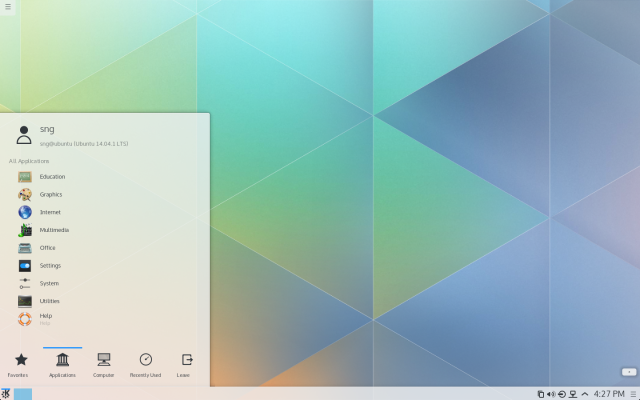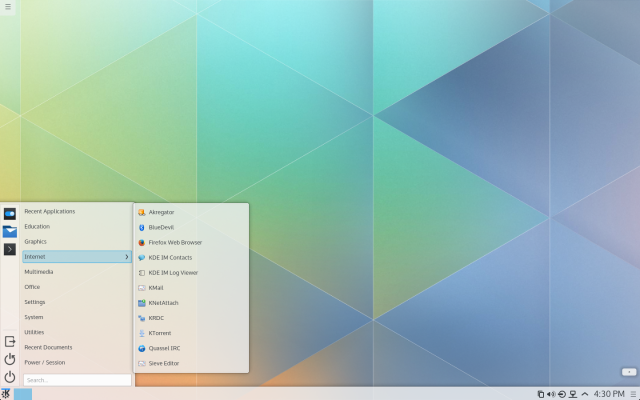So long Nepomuk, thanks for all the spinning fans
If you're a heavy user of KDE's sometimes awesome, sometimes not, search features, this may be the biggest news in Plasma 5. It's true, KDE has ditched Nepomuk in favor of a new search engine known as Baloo.
Nepomuk started life as an EU-funded metadata search project, with the lofty-sounding goal of creating a "Networked Environment for Personalized, Ontology-based Management of Unified Knowledge." By the time it trickled down to the KDE project, Nepomuk became a somewhat more mundane desktop search tool that alternated between brilliant and maddening.

Baloo takes much of what made Nepomuk great—namely, full text file search and an uncanny ability to pick up on relationships between files, for example, knowing that particular document is related to a contact—and improves it. Actually use the search features in Plasma 5 and you'll notice two things right off the bat: it's faster and your fan doesn't go haywire every time something new is indexed.
Baloo significantly reduces the resource footprint of searching and, according to KDE, is more accurate. We can't vouch for the latter, since we never used search much in older versions of KDE (see fan spinning comments), but in terms of accuracy, simple file searches in Plasma 5 are on par with what you'll find in Ubuntu, OS X, and elsewhere. The success of more complex searches involving relationships or complex metadata will vary depending on how much you use the default KDE apps. For example, you need to use the Kontact Suite if you want to take advantage of Baloo-based searches involving relationships between contacts and files.
That will likely change as time goes on, though, because another big change from Nepomuk is the new, improved developer API. The API for searching means third-party apps can tie in Plasma 5's Semantic Search infrastructure and take advantage of the same tools the default apps use.
Curiously, for something that has seen as much work as Baloo has, the visibility and discoverability of the search feature has taken a step backward. Fire up Plasma 5's Kickoff menu—KDE's answer to the Windows Start menu—and search is nowhere to be found. If you look closely, you'll see a tiny little reminder to "type to search," which is a step up from the first release (which had no indication that you could search). Still, this isn't as discoverable as a dedicated search box.
Kickoff and its new cousin, Kicker
KDE's answer to the Windows Start button has always been overkill in these eyes, packing too much in too little space, but with Breeze the menu has been cleaned up a bit and feels less visually overwhelming.

If it's still a bit too much for your needs, Plasma 5 offers a new, more traditional menu-based launcher called Kicker. Kicker does less—it's much closer to the Start menu in XP, a single, narrower pane that offers expanding menus where needed—and makes a lightweight alternative if all you want to do is launch applications and files. It also has a very obvious search box.

The other side of the menu bar has been revamped and cleaned up a bit as well. The most notable change is the notification app, which seems to kick up fewer notifications and does a better job of displaying them and quickly getting them out of the way.
OpenGL, QtQuick, and HiDPI Screens
Plasma 5 finishes up KDE's migration to Qt 5 and QtQuick, the latter of which uses a hardware-accelerated OpenGL scenegraph to render graphics. Most of what's new with OpenGL pertains to offloading graphics to any available GPU. That means, provided you've got the hardware for it, Plasma 5 can take full advantage of today's powerful GPUs.
Indeed, on newish hardware (our test MacBook's NVIDIA GeForce GT graphics card, for example) Plasma 5 is snappy, considerably snappier than its predecessor. Perhaps even more impressive, take away whatever GPU advantage Plasma 5 might gain over KDE 4.x systems, and it still feels faster. That is, running on older hardware still isn't KDE's strong point, but the story is better than it used to be. Still, if you're looking to get some extra mileage out of older hardware, stick with Xfce, LXDE or something even simpler like Openbox.
Interestingly, the revamped Frameworks that make up Plasma 5's graphics stack also pave the way for KDE to switch to the Wayland display server protocol. KDE doesn't seem to be in a hurry to make the switch to Wayland though, noting only that full support will be available in "a future release."
This release also claims improved support for HDPI displays. But, as with the HDPI support in GNOME and Unity, the actual experience is a very mixed bag. Font rendering in particular is nowhere near as smooth as what OS X offers. Even installing and fiddling with Infinality has never produced satisfactory results for me. We're still not sure if the problem is in setup, and we're not in fact seeing the new HDPI features. Or, possibly the KDE project just has a very different definition of what constitutes HDPI support. Hopefully it's the former.
What's missing
Earlier in this review, we said that the transition from KDE 4 to the Plasma 5 desktop would not be as bumpy as the move from KDE 3.x to 4.x. For the most part, that's true, but, for some people, there may be exceptions.
The KDE project says the focus for this release has been "concentrated on tools that make up the central workflows" and notes that "not all features from the Plasma 4.x series are available yet." That might ring a bell for those who made it through the KDE 3 to 4 transition.
In testing, we didn't run across any noticeable gaps in functionality or obvious missing features, save what was mentioned: the incomplete Breeze theme, some graphical glitches, and some questionable design choices. That said, have a look at the list of known issues, in particular the note about performance.
And we suggest trying Plasma 5 first to make sure all your must-haves are there before you jump in with both feet.
Conclusion
KDE's Plasma 5 release lacks the attention-grabbing, paradigm-shifting changes that keep Unity and GNOME in the spotlight. Instead, the KDE project has been focused on improving its core desktop experience. Plasma 5 is not perfect by any means, but, unlike Unity and GNOME, it's easy to change the things you don't like.
What's perhaps most heartening about this release is that KDE has managed to get a lot of the groundwork done for alternate interfaces without messing with their desktop interface much at all. The speed improvements are also good news. If you've tried KDE in the past and found it too "heavy," you might want to give Plasma 5 a fresh look.
reader comments
212